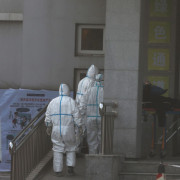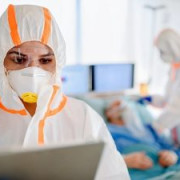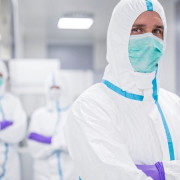Тест на антитела access sars-cov-2 igg†
Содержание:
- References
- Communicating risk and uncertainty
- Тест на антитела к коронавирусу класса IgG
- Background
- Так что же делать?
- Наличие антител в крови означает иммунитет к коронавирусу?
- Почему пока рано говорить, что антитела служат надежной защитой от коронавируса
- Interpreting antibody tests
- «Они не все плохие, просто можно нарваться»
References
-
Petherick A. Developing antibody tests for SARS-CoV-2. Lancet 2020;395:1101-2.
-
- Watson J,
- Whiting PF,
- Brush JE
. Interpreting a covid-19 test result. BMJ2020;369:m1808.
OpenUrl
-
Kucirka LM, Lauer SA, Laeyendecker O, Boon D, Lessler J. Variation in false-negative rate of reverse transcriptase polymerase chain reaction-based SARS-CoV-2 tests by time since exposure. Ann Intern Med 2020;173:262-7.
-
Lind S. GPs to provide covid antibody testing for patients who have bloods taken. Pulse; 2020. http://www.pulsetoday.co.uk/news/gps-to-provide-covid-antibody-testing-for-patients-who-have-bloods-taken/20040894.article.
-
- Deeks JJ,
- Dinnes J,
- Takwoingi Y,
- et al.,
- Cochrane COVID-19 Diagnostic Test Accuracy Group
. Antibody tests for identification of current and past infection with SARS-CoV-2. Cochrane Database Syst Rev2020;6:CD013652.
-
Arevalo-Rodriguez I, Buitrago-Garcia D, Simancas-Racines D, et al. False-negative results of initial RT-PCR assays for covid-19: a systematic review. MedRxiv 2020.doi:10.1101/2020.04.16.20066787%J.</unknown>
-
Long Q-X, Tang X-J, Shi Q-L, et al. Clinical and immunological assessment of asymptomatic SARS-CoV-2 infections. Nat Med 2020;26:1200-4.
-
Whiting PF, Rutjes AWS, Westwood ME, Mallett S; QUADAS-2 Steering Group. A systematic review classifies sources of bias and variation in diagnostic test accuracy studies. J Clin Epidemiol 2013;66:1093-104.
-
- Ibarrondo FJ,
- Fulcher JA,
- Goodman-Meza D,
- et al
. Rapid decay of anti-SARS-CoV-2 antibodies in persons with mild covid-19. N Engl J Med2020;doi:10.1056/NEJMc2025179.
OpenUrlCrossRefPubMed
-
Public Health England. Sero-surveillance of covid-19. 2020. https://www.gov.uk/government/publications/national-covid-19-surveillance-reports/sero-surveillance-of-covid-19.
-
Gallais F, Velay A, Wendling M-J, et al. Intrafamilial exposure to SARS-CoV-2 induces cellular immune response without seroconversion. MedRxiv 2020.doi:10.1101/2020.06.21.20132449%J
-
Le Bert N, Tan AT, Kunasegaran K, et al. SARS-CoV-2-specific T cell immunity in cases of COVID-19 and SARS, and uninfected controls. Nature 2020;584:457-62.
-
Duan K, Liu B, Li C, et al. Effectiveness of convalescent plasma therapy in severe COVID-19 patients. Proc Natl Acad Sci U S A 2020;117:9490-6.
-
Wu F, Wang A, Liu M, et al. Neutralizing antibody responses to SARS-CoV-2 in a covid-19 recovered patient cohort and their implications. MedRxiv 2020.doi:10.1101/2020.03.30.20047365%J
-
Fierz W, Walz B. Antibody dependent enhancement due to original antigenic sin and the development of SARS. Front Immunol 2020;11:1120.
-
Hart JT. The inverse care law. Lancet 1971;1:405-12.
-
Andersson M, Low N, French N, et al. Rapid roll out of SARS-CoV-2 antibody testing-a concern. BMJ 2020;369:m2420.
-
Scottish Government. COVID-19 antibody testing 2020. 2020 https://www.gov.scot/news/covid-19-antibody-testing-1
-
Martin J. Covid-19 testing: a national strategy. Royal College of Pathologists 2020. https://www.rcpath.org/uploads/assets/2e8d8771-f85a-408a-b5c8e68969cd21d5/cbcb4f30-d8f8-40fe-ba8cdef3e6803ee4/RCPath-COVID-19-testing-a-national-strategy.pdf
-
Watson J, de Salis I, Banks J, Salisbury C. What do tests do for doctors? A qualitative study of blood testing in UK primary care. Fam Pract 2017;34:735-9.
-
Petrie KJ, Sherriff R. Normal diagnostic test results do not reassure patients. Evid Based Med 2014;19:14.
-
Rolfe A, Burton C. Reassurance after diagnostic testing with a low pretest probability of serious disease: systematic review and meta-analysis. JAMA Intern Med 2013;173:407-16.
-
- Weinstein MC,
- Freedberg KA,
- Hyle EP,
- Paltiel AD
. Waiting for certainty on covid-19 antibody tests—at what cost?. N Engl J Med2020;383:e37.doi:10.1056/NEJMp2017739.
OpenUrlCrossRef
-
Kofler N, Baylis F. Ten reasons why immunity passports are a bad idea. Nature 2020;581:379-81.
Communicating risk and uncertainty
Covid-19 offers an opportunity to improve clinician and patient understanding and communication of risk and uncertainty in diagnostic testing. Residual uncertainty after diagnostic testing is normal, and the same principles discussed here apply to most screening and diagnostic tests. We hope that the interest in covid-19 testing will lead to a wider debate around testing and test evaluation where accuracy of tests haven’t been as closely scrutinised. Clinicians should consider the risks and benefits of SARS-CoV-2 antibody testing for individuals, and share information about the limitations of testing with patients (). High quality evidence on test accuracy is currently lacking, and further research is needed to address areas of uncertainty (). A drive to increase volumes of tests performed without considering the clinical value of testing could be an expensive distraction from key public health interventions. Yet carefully considered testing, in patients with late presentation of the illness, or prolonged or atypical symptoms could help reduce uncertainty, guide ongoing management, and improve understanding of the late sequelae of covid-19.
Box 1
What you might tell your patient
-
Antibody tests help us find out who has had covid-19 in the past
-
They cannot tell us for sure whether you can catch covid-19 in the future
-
If the test is positive then it is likely that you have been infected at some time
-
A negative test result cannot rule out the possibility that you have had covid-19
Box 2
Uncertainties
-
Most studies on antibody tests are from patients in hospital. We do not know how well the tests work in patients with mild illness who were not admitted to hospital, or in people who are asymptomatic
-
Data are lacking on test accuracy beyond 35 days—we do not know how well these tests will work for infections that occurred more than five weeks ago
-
Evidence is insufficient to know whether the presence of antibodies confers lasting immunity to protect against future covid-19 infection
How patients were involved in the creation of this article
Two patient representatives from the University of Birmingham patient and public involvement panel reviewed this article. The feedback was that the article was interesting and readable, and the case studies were realistic. As a result of the feedback, we made changes to the wording of , “What you might tell your patient.”
How this article was made
This article was produced at speed to address an urgent need for evidence. JD has recently led a Cochrane systematic review of the diagnostic accuracy of covid-19 antibody tests, and this paper is based on the evidence from this systematic review, with clinical input from JW and AR.
Тест на антитела к коронавирусу класса IgG
Для чего нужен: Диагностика перенесенной инфекции COVID-19 (пост-фактум); в будущем – оценка эффективности вакцины.
Кто должен сдавать:
- Те, кто могли переболеть инфекцией: лица, в прошлом имевшие острые симптомы или лица, имевшие достоверный контакт с инфицированным человеком или человеком с острыми симптомами. При этом мазок ПЦР не проводился, либо есть основания считать, что он мог быть ложноотрицательным
- Те, кто хотят узнать статус своего иммунитета к коронавирусной инфекции
Когда делать: Антитела IgG обнаруживаются в крови на 3-4 неделе с момента контакта с вирусом SARS-CoV-2.
Комментарий: Антитела класса IgG могут сохраняться в организме человека длительное время, поэтому выявление их в крови однозначно свидетельствует о том, что человек переболел коронавирусом. Таким образом, тест рассматривается в качестве поздней диагностики COVID-19 и в качестве подтверждения диагноза при осложнениях (мультисистемный воспалительный синдром).
Существует две разновидности тестов на антитела. Экспресс-тест показывает только наличие или отсутствие антител (кровь берется из пальца). Как видно из названия, его преимущество в скорости анализа: результат можно получить уже через 20 минут. Иммуноферментный анализ, в отличие от экспресс-теста, предполагает забор крови из вены и показывает концентрацию антител в крови, благодаря чему можно сделать вывод о стадии заболевания.
Зачастую лаборатории предлагают сдать анализ на оба вида антител.
В начале эпидемии ученые говорили о том, что серологическое тестирование поможет им установить уровень коллективного иммунитета в разных странах. Однако сейчас эксперты не рекомендуют применять тест на антитела в этих целях: сначала необходимо установить наличие, стойкость и продолжительность иммунитета у переболевших COVID-19.
Background
Serologic assays for SARS-CoV-2, now broadly available, can play an important role in understanding the virus’s epidemiology in the general population and identifying groups at higher risk for infection. Unlike direct detection methods such as viral nucleic acid amplification or antigen detection tests that can detect acutely infected persons, antibody tests help determine whether the individual being tested was previously infected—even if that person never showed symptoms. Serologic tests detect resolving or past SARS-CoV-2 virus infection indirectly by measuring the person’s humoral immune response to the virus. Therefore, serologic assays do not typically replace direct detection methods as the primary tool for diagnosing an active SARS-CoV-2 infection, but they do have several important applications in monitoring and responding to the COVID-19 pandemic.
Although serologic tests should not be used at this time to determine if an individual is immune, these tests can help determine the proportion of a population previously infected with SARS-CoV-2 and provide information about populations that may be immune and potentially protected. Thus, demographic and geographic patterns of serologic test results can help determine which communities may have experienced a higher infection rate and therefore may have a higher proportion of the population with some degree of immunity, at least temporarily. In some instances, serologic test results may assist with identifying persons potentially infected with SARS-CoV-2 and determining who may qualify to donate blood that can be used to manufacture convalescent plasmaexternal icon as a possible treatment for those who are seriously ill from COVID-19.
Так что же делать?
ЦКЗ дает несколько советов по использованию тестов на антитела.
Прежде всего, результаты теста следует интерпретировать в контексте ожидаемых прогностических значений, положительных и отрицательных. Если с помощью одного теста невозможно обеспечить высокое положительное прогностическое значение, следует использовать повторный анализ.
Серологическое тестирование не должно использоваться для определения иммунного статуса у людей до тех пор, пока не будет установлено наличие, длительность и продолжительность иммунитета. Но оно может быть предложено в качестве метода подтверждения диагноза COVID-19 у людей, у которых прошло 9-14 дней с момента появления симптомов.
Люди, у которых выявили антитела, должны продолжать следовать общим рекомендациям по предотвращению заражения SARS-CoV-2 и жить нормальной жизнью, в том числе и работать. Однако результаты серологических тестов не должны использоваться при принятии решения о совместном проживании людей в общежитиях или исправительных учреждениях, а также открытии школ и возвращении на рабочее место.
Наличие антител в крови означает иммунитет к коронавирусу?
Почему пока рано говорить, что антитела служат надежной защитой от коронавируса
Interpreting antibody tests
Interpretation of test results depends not only on the accuracy of the test itself but also the pre-test probability of infection. This will vary widely depending on the indication for testing: when screening asymptomatic individuals the pre-test probability will be relatively low, for those with suggestive symptoms it is likely to be much higher. We illustrate this with two (fictitious) clinical cases.
Case 1
Anthony is 53, has type 2 diabetes, and a raised body mass index. He works as a security guard in a shopping centre in Norwich. His wife is worried about his risk of exposure to covid-19 at work, and phones the GP surgery requesting an antibody test. He has not had any suggestive symptoms and has no known exposure.
Anthony’s pre-test probability can be estimated based on the population SARS-CoV-2 antibody seroprevalence in his area; in the East of England this is estimated to be around 10%. As he has had no symptoms or known exposure his probability of asymptomatic seroconversion is likely to be lower; for illustrative purposes we estimate his pre-test probability at 5%.
We do not have any data on the accuracy of antibody assays in asymptomatic people on which to base our estimates. We will start by using the average sensitivity of 91.4% and average specificity of 98.7% from the Cochrane review and consider what would change if, as is likely, the test had a lower sensitivity. illustrates the outcomes of testing based on 1000 people like Anthony, with a pre-test probability of 5%. We would expect that 942 people would test negative, of whom four (0.4%) would actually have had covid-19 (false negatives). Considering that the test may well have a lower sensitivity, particularly if the peak incidence and therefore likely time of infection is >35 days ago, this would proportionally increase the false negative rate. If the test made five times as many false negatives (sensitivity of 57%) then this would rise to 20 false negatives (2.1%)—still relatively low numbers owing to the low prevalence. A negative test result would therefore mean Anthony is unlikely to have had covid-19 infection. However, of the 58 people who would test positive, 12 people (21%) would be falsely positive. This is important because a false positive could potentially influence Anthony’s behaviour and adherence to infection control measures. This could be particularly risky as Anthony has an occupational risk of exposure and comorbidities, placing him at higher risk of complications from covid-19. The GP should therefore explain that the test result cannot be used to indicate immunity, and that regardless of the results of testing, Anthony should follow recommended precautions to avoid exposure to SARS-CoV-2. The test result in this case is therefore unlikely to change any advice given to the patient, and has the potential to cause harm through false reassurance.
Fig 1
Infographic showing outcomes of SARS-CoV-2 antibody testing based on 1000 people with a pre-test probability of 5%
«Они не все плохие, просто можно нарваться»
— То, что тесты есть в продаже как в сети Интернет, так и в аптеках, мы однозначно в курсе, — сообщила нашему изданию Лейла Фазлеева. — В целом в России зарегистрированы и разрешены к применению 84 экспресс-тест-системы для определения антител к новой коронавирусной инфекции. Факт регистрации подтверждает то, что данная продукция разрешена к применению. Цены на них не подлежат государственному регулированию. Их формирование осуществляется в зависимости от отпускных цен производителей, отпускных цен организаций оптовой торговли, даты поставки, объема закупок.
Более категорично о стоимости, а также о качестве экспресс-тестов на коронавирус высказался директор научно-клинического центра прецизионной и регенеративной медицины КФУ.
— Что касается цен, то они устанавливаются «от балды». Если говорить о качестве, то в начале пандемии Европа вернула несколько китайских партий из-за низкого качества. Это не значит, что они все плохие, просто можно нарваться на всякое
Важно понимать, есть у этих тестов регистрационные удостоверения или нет, поскольку это тоже определенная проверка, — резюмировал Альберт Ризванов
Лина Саримова
ОбществоМедицина Фазлеева Лейла РинатовнаРизванов Альберт Анатольевич






